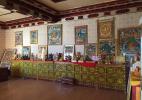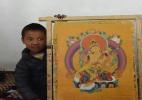Nov. 1, 2016 -- As you walk past the winding mountain path with the bleating sound of sheep, a classic Tibetan building with a wooden lintel appears before your eyes.
As you push open the bright red door adorned with Khada, a strong smell of Tibetan incense blows in your face. In the yard is Gangzhu Tibetan incense factory. The factory is not far from Namling County, Lhasa City. The boss is called Lozang Choden.
Apart from running a Tibetan incense business, he also teaches students Thangka painting skills. However, he only takes on students with birth defects and most of them come from poor families living nearby.
Lozang Choden provides shelter for these children who are unable to find a suitable job. He then teaches them Thangka painting skills, allowing them to provide for themselves.
In Lozang’s view, passing on Thangka skills is more important than making money. Therefore, he prefers the position of Thangka teacher to the position of Tibetan incense factory boss.
Thangka is a Tibetan transliteration and it refers to the scroll paintings in the monasteries or Tibetan homes for worship. This unique form of Tibetan painting relates to Tibetan history, politics, culture, social life and many other areas.
It is painted following a strict set of fixed rules regarding proportion. Traditionally, colors are derived by grinding various precious minerals such as gold, silver, pearls, coral and others. Therefore, it can be said that a piece of Thangka is priceless.
But as far as Tibetans are concerned, the reason for Thangka being valuable isn’t down to money, but more down to the Thangka content being related to the Buddha. For religious believers, this is a kind of heartfelt belief.
23-year-old Tsetop has already been coming to Thangka class for five years. In these years, he has gradually learnt painting skills and now, not only gets a good price for his work, but also teaches others. Tsetop makes between 20 and 30 thousand yuan every year from Thangka painting.
16-year-old Sonam Gonpo has been learning for two years. He can now complete a basic Thangka painting by himself. The learning environment in the studio is relaxed, but the teacher puts his heart and soul into the teaching, and gives him plenty of time to complete each piece of work.
13-year-old Tsewang is the Thangka teacher’s youngest apprentice and when he first arrived he didn’t even understand the Tibetan alphabet.
Thangka painting is a process that requires constant study and accumulation. It requires learning a lot of historical materials as well as painting skills. Therefore, Tsewang must learn basic Tibetan grammar at the same time as learning Thangka painting. He has already completed his first piece of Thangka on his own.
According to Lozang Choden, the name of the factory means the “snow area’s son” in Tibetan. He wants to be snow area’s son and provide a contribution to poverty alleviation in the snow areas. Lozang used to be a monk and learned his Thangka painting skills in the monastery.
In 2008 he opened a small Thangka workshop in Namling County. Later, with help from the local government, he started a Thangka training class in 2011.
In 2013 he opened the Tibetan incense factory and recruited poor villagers from surrounding areas. Looking to the future, Lozang hopes to expand his brand with the villagers, make it into an industry and provide more jobs to villagers.







